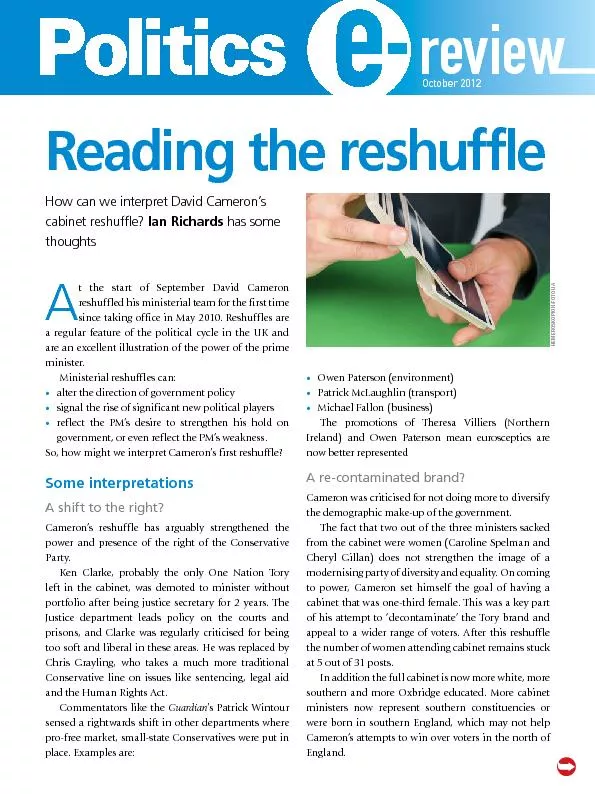/


cabinet reshuffle Ian Richards has some thoughts A t the start of September David Cameron reshuffled his ministerial team for the first time since taking office in May 2010 Reshuffles are a re ID: 415861
Download Pdf The PPT/PDF document "How can we interpret David Cameron’..." is the property of its rightful owner. Permission is granted to download and print the materials on this web site for personal, non-commercial use only, and to display it on your personal computer provided you do not modify the materials and that you retain all copyright notices contained in the materials. By downloading content from our website, you accept the terms of this agreement.
How can we interpret David Cameron’s cabinet reshuffle? Ian Richards has some thoughts A t the start of September David Cameron reshuffled his ministerial team for the first time since taking office in May 2010. Reshuffles are a regular feature of the political cycle in the UK and minister. Ministerial reshuffles can: alter the direction of government policy signal the rise of significant new political players reflect the PM’s desire to strengthen his hold on government, or even reflect the PM’s weakness. So, how might we interpret Cameron’s first reshuffle? Some interpretations A shift to the right? Cameron’s reshuffle has arguably strengthened the power and presence of the right of the Conservative Party. Ken Clarke, probably the only One Nation Tory left in the cabinet, was demoted to minister without portfolio after being justice secretary for 2 years. The Justice department leads policy on the courts and prisons, and Clarke was regularly criticised for being Chris Grayling, who takes a much more traditional Conservative line on issues like sentencing, legal aid and the Human Rights Act. Commentators like the Guardian ’s Patrick Wintour sensed a rightwards shift in other departments where pro-free market, small-state Conservatives were put in place. Examples are: Owen Paterson (environment) Patrick McLaughlin (transport) Michael Fallon (business) The promotions of Theresa Villiers (Northern Ireland) and Owen Paterson mean eurosceptics are now better represented A re-contaminated brand? Cameron was criticised for not doing more to diversify the demographic make-up of the government. from the cabinet were women (Caroline Spelman and Cheryl Gillan) does not strengthen the image of a modernising party of diversity and equality. On coming to power, Cameron set himself the goal of having a cabinet that was one-third female. This was a key part of his attempt to ‘decontaminate’ the Tory brand and appeal to a wider range of voters. After this reshuffle the number of women attending cabinet remains stuck at 5 out of 31 posts. In addition the full cabinet is now more white, more southern and more Oxbridge educated. More cabinet ministers now represent southern constituencies or were born in southern England, which may not help Cameron’s attempts to win over voters in the north of England. Reading the reshuffle review HEMEROSKOPION/FOTOLIA October 2012 A weakened PM? Almost as soon as the reshuffle was completed Nick Robinson (BBC political editor) reported that Cameron had tried to move Iain Duncan Smith from his post as secretary of state for work and pensions. Duncan Smith refused to move and has stayed in place. Given that the power of patronage is one of a PM’s key powers, the refusal of a minster to shift post does not reflect well on Cameron’s ability to manage his team. Moreover, as the Daily Telegraph pointed out, Cameron’s room for manoeuvre was limited by other, more important, factors. Because the Conservatives are in coalition, Cameron had no real control over about one fifth of his cabinet. All the Lib Dems stayed in post. This reinforces the point that Cameron faces a unique situation for a prime minister. His power to appoint, dismiss and demote is significantly limited by the circumstances of his election ‘win’. A future mini-reshuffle? If the chief whip, Andrew Mitchell, resigns over comments he made to a Downing Street police officer in late September, Cameron may find himself recruiting again in the near future. Activities 1 Why are cabinet reshuffles a sign of both strength and weakness in a prime minister? 2 How significant was Cameron’s first reshuffle? 3 Research previous ministerial reshuffles. In what ways did they reflect the position of the PM at the time? (You might like to consider Harold Macmillan’s ‘Night of the Long Knives’ reshuffle in 1962.) Weblinks to follow up Fewer women in key posts: www.tinyurl.com/d8l2gch Who’s who in the cabinet? www.tinyurl.com/9kck84s How have Tory supporters reacted to the reshuffle? This was a clever reshuf e which has put effective MPs, like Greg Clark, Michael Fallon and Liz Truss, into departments where more economic activity is neededThe reshuf e doesn’t alter the fact that Cameron, Clegg and Osborne will Because of the constraints of the Coalition the reshuf e won’t make a big difference to the direction of the GovernmentAgreeDisagree 47%91%60%68%82%74%19%90%71%Source: Conservativehome.com review Did you like this article? Tell us what you think Find out more about our full range of magazines and online archives of back issues at www.philipallan.co.uk/magazines